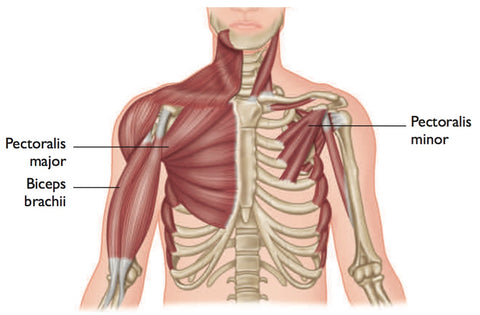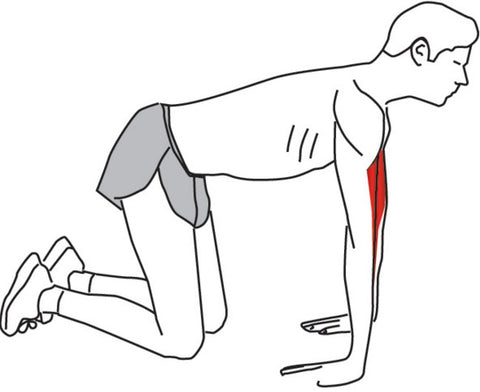Stretching for Pain Relief and Rehabilitation - Biceps Brachii
Treating Biceps Brachii - Dr. Jonathan Kuttner
Muscle strains are among the most common sports injuries and often result from the sudden extension of a joint beyond its normal range. This causes damage to muscle and other soft tissue.
Weight training, sudden, violent torsion of the shoulder during throwing sports or sudden force applied to the nexus of the pectorals and biceps brachii (as when warding off a check in hockey with the arm extended) can produce such injuries.

Bicep Brachii Muscle Strains are characterized by tenderness and pain over the affected muscle, stiffness, and pain during muscle use. Note: The chest muscles (pectoralis major and minor) join the biceps brachii muscle at the shoulder.
Cause of injury
Sudden movement leading to a muscle tear. Large physical demand placed on the muscle. Warding off a check in hockey or tackle in football.
Signs and symptoms
Tenderness and pain over the affected muscle. Stiffness. Pain during muscle use.
Complications if left unattended
Muscle strains are usually self-limiting and repair themselves given proper time off from exertion for healing. Insufficient recovery time can lead to further tearing, increasing the risk of re-injury and cause degenerative changes in the muscles over time.
Immediate treatment
RICER regimen and analgesics to reduce inflammation and pain. Then heat to promote blood flow and healing.
Rehabilitation and prevention
Stretching exercises following healing can help restore full mobility to the affected area while strengthening exercises can help prevent re-injury.
Stretching and warm-up, as well as attention to proper athletic technique (particularly in weight training) may help prevent this type of injury.
Long-term prognosis
Muscle strains involving the pectoral muscles and/or biceps brachii are common and – given adequate time for proper healing – generally not a serious threat to the athlete, although severe or repeated muscle strains can cause chronic pain and lead to impairment of muscle function.

TECHNIQUE
While crouching on your knees with your forearms facing forward and hands pointing backwards, slowly move rearward.
MUSCLES BEING STRETCHED
Primary muscles: Biceps brachii. Brachialis. Brachioradialis. Coracobrachialis.
Secondary muscles: Pronator teres. Flexor carpi radialis. Flexor carpi ulnaris. Palmaris longus.
INJURY WHERE STRETCH MAY BE USEFUL
Biceps tendon rupture. Bicepital tendonitis. Biceps strain. Elbow strain. Elbow dislocation. Elbow bursitis. Tennis elbow. Golfer’s elbow. Thrower’s elbow.
Trigger points in the biceps muscles typically refer pain to the front of the shoulder, radiating down to the inside of the elbow.

ADDITIONAL INFORMATION FOR PERFORMING THIS STRETCH CORRECTLY
Depending on where your muscles are most tight, you may feel this stretch more in your forearms or more in your upper arms. To make this stretch easier, move your hands towards your knees.
Find a Trigger Point Professional in your area
Dry Needling for Trigger Points
Certify as a Trigger Point Therapist
Trigger Point Therapy Certification Courses:
This trigger point therapy blog is intended to be used for information purposes only and is not intended to be used for medical diagnosis or treatment or to substitute for a medical diagnosis and/or treatment rendered or prescribed by a physician or competent healthcare professional. This information is designed as educational material, but should not be taken as a recommendation for treatment of any particular person or patient. Always consult your physician if you think you need treatment or if you feel unwell.

About Niel Asher Education
Niel Asher Education (NAT Global Campus) is a globally recognised provider of high-quality professional learning for hands-on health and movement practitioners. Through an extensive catalogue of expert-led online courses, NAT delivers continuing education for massage therapists, supporting both newly qualified and highly experienced professionals with practical, clinically relevant training designed for real-world practice.
Beyond massage therapy, Niel Asher Education offers comprehensive continuing education for physical therapists, continuing education for athletic trainers, continuing education for chiropractors, and continuing education for rehabilitation professionals working across a wide range of clinical, sports, and wellness environments. Courses span manual therapy, movement, rehabilitation, pain management, integrative therapies, and practitioner self-care, with content presented by respected educators and clinicians from around the world.
Known for its high production values and practitioner-focused approach, Niel Asher Education emphasises clarity, practical application, and professional integrity. Its online learning model allows practitioners to study at their own pace while earning recognised certificates and maintaining ongoing professional development requirements, making continuing education accessible regardless of location or schedule.
Through partnerships with leading educational platforms and organisations worldwide, Niel Asher Education continues to expand access to trusted, high-quality continuing education for massage therapists, continuing education for physical therapists, continuing education for athletic trainers, continuing education for chiropractors, and continuing education for rehabilitation professionals, supporting lifelong learning and professional excellence across the global therapy community.

Continuing Professional Education
Looking for Massage Therapy CEUs, PT and ATC continuing education, chiropractic CE, or advanced manual therapy training? Explore our evidence-based online courses designed for hands-on professionals.




















